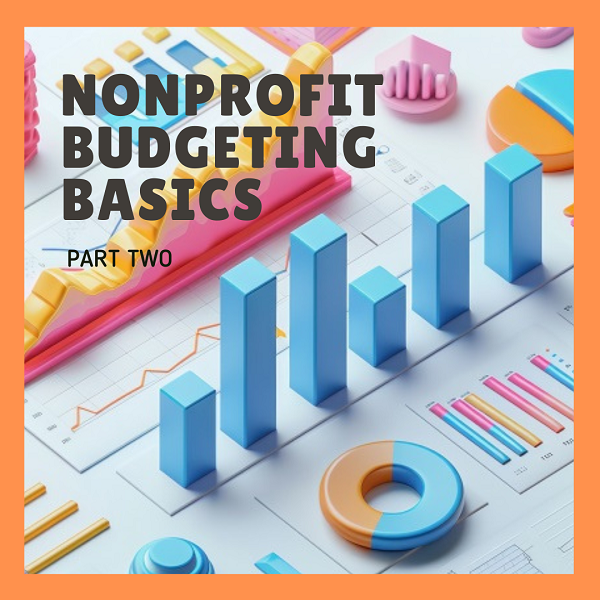 Welcome back to our three-part article series on nonprofit budgeting basics. In Part 1, we shared three basic budgeting types common to nonprofits: operating, program, and grant budgets. In this article, Part 2, we’ll explore four additional budget types. In Part 3 we will discuss budget forecasting.
Welcome back to our three-part article series on nonprofit budgeting basics. In Part 1, we shared three basic budgeting types common to nonprofits: operating, program, and grant budgets. In this article, Part 2, we’ll explore four additional budget types. In Part 3 we will discuss budget forecasting.
Four Additional Nonprofit Budget Types to Know
Now that you’ve gained a basic understanding of operating, program, and grant budgets, let’s look at four more commonly used nonprofit budget types. These include:
1. Cash Flow
2. Capital
3. Fundraising
4. Special Events
Cash Flow Budgets
Cash flow budgets track the inflows and outflows of cash over a specific period, typically monthly or quarterly. They may be used for the whole organization or a particular project. This type of budget helps the organization manage its liquidity, ensuring it has enough cash on hand to meet its obligations as they come due.
This type of budget outlines the expected cash receipts from donations, grants, program fees, fundraising events, and investment income, as well as the cash payments for operating expenses, program costs, fundraising expenses, and capital expenditures. The organization can monitor its financial health and make necessary adjustments by comparing actual cash flows to the budgeted amounts.
Cash flow budgets also aid in planning for future cash needs, making informed decisions about spending, fundraising, and investments, and ensuring transparency and accountability to stakeholders. It also includes contingency funds for unexpected expenses or financial shortfalls.
Monitoring the cash flow budget is essential for a nonprofit's financial stability, ensuring it can meet its financial obligations and operate smoothly with enough cash reserves to cover anticipated expenses.
Capital Budgets
Capital budgets generally address revenues and expenses related to a large, discrete project or major capital expense over a specific period. These expenditures include long-term investments in assets like buildings, equipment, and technology crucial for the organization's operations and growth.
Organizations can maintain long-term sustainability and support their mission by planning for these significant expenses. Capital budgets also aid in managing cash flow by projecting when large sums of money will be needed, helping to avoid financial surprises.
Capital budgets include detailed projections for costs related to buildings and facilities, equipment and technology, vehicles, and furniture and fixtures. Funding sources for these projects might come from grants and donations, loans, reserves, or special fundraising campaigns. Additionally, the budget will outline project timelines and plans for breaking down large projects into manageable phases.
With a capital budget, nonprofits can make informed decisions about capital investments and prioritize projects based on their impact and urgency. This ensures they can maintain and enhance their infrastructure, supporting their mission and long-term goals.
Fundraising Budgets
To make money, you have to spend money, and to raise funds, you have expenditures. Thus, fundraising budgets are another planning tool. These budgets outline the expected costs and revenues from fundraising activities over a specific fiscal year period.
A fundraising budget details the financial resources needed to execute campaigns and events. It includes projections for both the income generated and the expenses incurred. Tracking actual expenses and revenues against the budget allows you to monitor the effectiveness of your efforts and make necessary adjustments.
Revenue projections in a fundraising budget include expected donations from individuals, businesses, and foundations, income from events like galas and auctions, sponsorships from corporate partners, and grants for fundraising activities. Expense projections cover marketing and promotion costs, event expenses, staffing salaries and benefits, technology tools, and administrative costs.
Special Events Budgets
Does your organization host conferences? Galas? Major events? If so, it may benefit from a special events budget, which tracks income and expenses for a single event. This budget helps you plan and manage the financial aspects of the event to ensure it is financially viable.
A special events budget details all the financial resources needed to organize and execute the event. It includes projections for both the income generated and the expenses incurred. Revenue projections in a special events budget may include ticket sales, sponsorships from corporate partners, donations from attendees, auction and raffle sales, and merchandise sales, depending on the nature of the event itself. Expense projections cover venue costs, catering, marketing and promotion, entertainment, staffing, decorations and supplies, technology needs, and administrative costs.
Special event budgets help organizations track and monitor events over time, too. Often, organizations host events that become a ‘fixture’ of the annual budget. Perhaps the organization always holds a gala in December or a conference in June. As the years pass, the activities become sacrosanct; “we always do this” type of activities. By keeping a unique special events budget, stakeholders can review the income and expenses with a fresh eye each year, focusing on the event as a revenue-generating activity to support the organization’s mission.
About AccuFund - Nonprofit Accounting Software Makes Budgeting Easier
Nonprofit accounting software, with features of robust budgeting and forecasting tools, real-time financial tracking, and automated reporting for detailed insights, helps make budgeting easier and streamlines financial management to effectively support your nonprofit's mission.
Additionally, ensure the software offers strong security measures, scalability to grow with your organization, and integration capabilities with other systems.
Related Materials
Nonprofit Budgeting Basics Blog - Part One
AccuFund Nonprofit Accounting Software
AccuFund Budget Development
Nonprofit Storytelling White Paper
Nonprofit Accounting - Register for Webinar